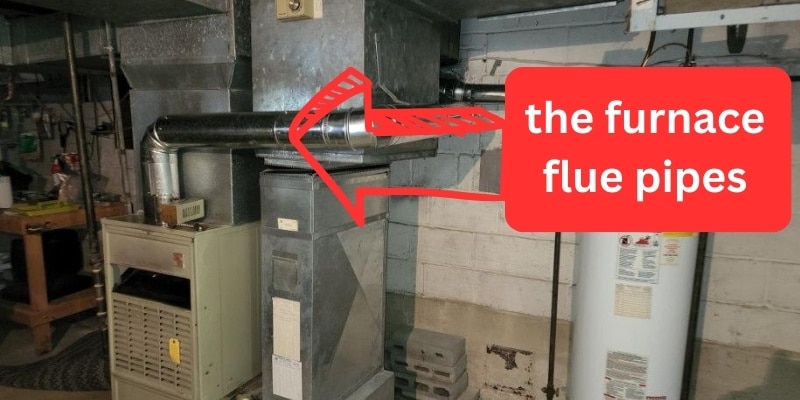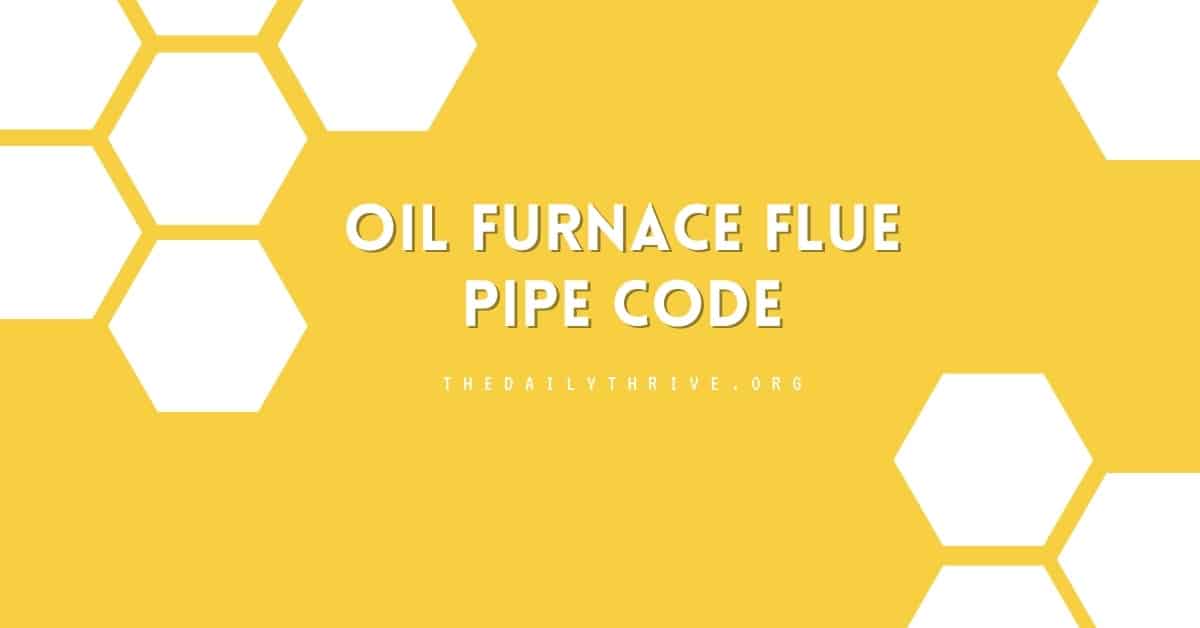If you’re like me, the comfort and safety of your home are your top priorities. That’s why we can’t afford to overlook any aspect of our household appliances, especially something as integral as an oil furnace. The ‘Oil Furnace Flue Pipe Code‘ might sound like technical jargon, but stick with me, and you’ll see why this piece of regulation is a guardian angel in our homes.
Now, you might be wondering, “Why should I concern myself with something as technical as this?”
Well, it’s because this isn’t just about following rules; it’s about safeguarding our homes, our comfort, and most importantly, our lives. These regulations are meticulously crafted to ensure that the very air we breathe inside our homes is safe and that the systems we rely on function as efficiently as possible without posing any hazards.
But here’s something that often slips our minds: the installation of the furnace must allow for an adequate supply of combustion air. Yes, that’s the very air that supports the burning of fuel inside your furnace. Without enough of it, we’re looking at incomplete combustion and the risk of dangerous gases infiltrating our safe spaces.
Moreover, the location and design of the combustion air opening of the furnace must be such that it’s snow-blockage-proof. Picture this: it’s the dead of winter, snow is piling up, and unknowingly, it’s cutting off your furnace’s air supply. That’s a situation we all want to avoid.
Now, here’s a detail that requires your undivided attention: when drawing combustion air from underneath the home, it’s imperative to ensure that a vent or duct provides at least 18 square inches of free area from the outside. This specification isn’t arbitrary; it’s the minimum requirement to maintain adequate airflow for combustion.
But don’t just set it up and forget it! Regular checks to ensure that the combustion air opening is unobstructed are essential. It’s like keeping the nostrils of your home clear – for the very breath of your heating system!
Let’s not forget the specifics of installation. When you opt for a combustion air duct, it needs to extend right through the floor, not just meander underneath. And for those using the direct vent kit, remember that the combustion air opening must be located in the same pressure zone as the flue exit of the roof jack or chimney. Aligning these elements is crucial for maintaining the pressure balance and ensuring the efficient, safe operation of your oil furnace.
The Oil Furnace Flue Pipe Code is more than a set of rules; it’s a guidebook for health, efficiency, and peace of mind. So, let’s dive deeper into understanding each facet of this life-preserving set of guidelines!
What is an Oil Furnace?
In the sanctuary of our homes, especially during those teeth-chattering months of winter, a furnace acts as the heart of the heating system. This vital organ isn’t just a metal box; it’s a complex system where the combustion of fossil fuel takes place and warmth begins.
Among its siblings, the oil furnace has its niche, requiring fuel oil to bring heat to your living spaces. It’s particularly popular in those regions where Jack Frost visits more often, notably the colder climates like the northeastern United States.
How does an oil furnace work?
Imagine the oil furnace as a kind of friendly fire-breathing dragon sitting in your home. This creature’s diet is fuel oil, and it breathes out not fire but warmth. When the oil is gobbled up in the furnace’s combustion chamber, it creates heat. This heat isn’t for keeping the furnace warm; it’s transferred to the air that wafts through the furnace’s heat exchanger. Once heated, this air is then propelled into your home, spreading warmth.
The fuel oil itself has its own house outside – a tank – from where it’s pumped into the furnace as needed. And the soul of this dragon? The main components like burners, heat exchangers, blowers, and controls keep the magic happening.
What’s the difference between an oil furnace and a gas furnace?
Here’s where the plot thickens. Oil furnaces and gas furnaces might seem like twins, but they’re more like cousins. The most glaring difference is their diets: oil furnaces consume fuel oil, while gas furnaces prefer munching on natural gas or propane. But the differences don’t end at their palates.
Oil furnaces often demand more attention and TLC in terms of maintenance, and they tend to be a bit more laid-back in their work ethic, with efficiency levels lounging between 80 and 90 percent. Gas furnaces, on the other hand, are the overachievers of the furnace family, boasting energy efficiency levels that can soar between 80 and 97 percent.
And then, there’s the matter of expenses. The cost of adopting a new gas or oil furnace can differ, and so does the cost of their respective diets – fuel oil and natural gas. These differences can significantly impact your budget, both short-term and long-term.
What are Furnace Flue Pipes?
Peeling back another layer of our home heating system, we encounter the unsung heroes of our comfort and safety: the furnace flue pipes.

These components might not look like much at first glance. Still, they serve a critical purpose: they’re the escape route for exhaust gases from the heating appliances in your cozy abode. Picture them as the busy highways leading out of the city, each dedicated to a different neighborhood.
Similarly, you might have several flue pipes, each serving a specific appliance – your gas furnace, the kitchen stove, or even that fancy indoor grill you love.
But what are these pipes made of? The materials of choice are usually stainless steel liners or terracotta clay, celebrated for their less porous natures compared to mortar bricks. This characteristic is crucial, as it thwarts any sneaky, toxic by-products that might want to set up camp in the flue.
How Does a Furnace Flue Work?
Inside the world of the furnace flue pipe, there’s a component that plays a vital role: the damper. Nestled within the stack, this part regulates the pressure difference between your furnace’s internal atmosphere and the great outdoors. This pressure management is what gives exhaust gases a one-way ticket out of the furnace’s combustion chamber and into the flue pipe, then making their grand ascent out of your home.
The principle steering this operation is the “natural draft.” It’s like the flue gases have volunteered to leave, recognizing they’ve overstayed their welcome. These gases, you see, are warmer than the air entering the furnace, which means they naturally rise. The damper just gives them a little nudge, ensuring they don’t make any U-turns back into your living space.
However, the world inside these pipes needs balance. Too little or too much pressure can throw a wrench in the works, potentially leading to damage or, worse, trapping those unwanted gases inside your home. Factors contributing to these pressure woes can include narrow pipes, an abundance of joints, or excessive horizontal sections.
Why is a Furnace Flue Pipe Important?
Here’s the deal: the furnace’s combustion chamber is where the magic happens. It’s where fuel dances with oxygen, producing both heat and combustion by-products. But some of these by-products, like carbon monoxide, are no joke; they’re downright dangerous.
Without the flue pipe serving as a bouncer, these toxic gases could mingle in the air you breathe, leading to health risks like carbon monoxide poisoning. Furthermore, when these hot gases meet materials that love to burn (think wood or paper), there’s a fire hazard. Here again, the flue pipe steps in as a preventative barrier, stopping these gases from initiating a dangerous liaison.
In its construction, a flue pipe incorporates metal and an insulating layer. It’s strategically sloped towards the chimney, allowing the gases a smooth journey from the furnace to the outside world, ensuring that your home remains a safe sanctuary. So, while it might just seem like a pipe, it’s continuously safeguarding your comfort and, more importantly, your life.
The Importance of Adhering to Oil Furnace Flue Pipe Codes
Why are these oil furnace flue pipe codes a big deal?
This is where the rubber meets the road. Codes surrounding the installation and maintenance of your oil furnace flue pipe are not just bureaucratic red tape; they are critical safety measures. These regulations ensure the proper expulsion of toxic gases, prevent fire hazards, and safeguard your home’s air quality.
From the get-go, the installation must allow for an adequate combustion air supply. Specific requirements, such as an 18-square-inch free area vent from the outside or ensuring unobstructed combustion air openings, are crucial. These stipulations prevent blockages by snow or other debris.
Moreover, these codes pay attention to the nitty-gritty. Whether it’s the extension of the combustion air duct through the floor, the positioning of the direct vent kit, or the precise location of the combustion air opening, each detail is about safeguarding your home environment.
Why cutting corners with your oil furnace flue pipe codes is dangerous?
Here’s the hard truth: ignoring these codes isn’t just a legal risk; it’s a gamble with life itself. Bypassing these regulations means flirting with disasters like carbon monoxide poisoning and even house fires. Compliance isn’t red tape; it’s about shielding our loved ones and homes from harm.
Understanding the ins and outs of your oil furnace and flue pipe system isn’t just for technicians. As homeowners, recognizing the importance of each component, the reason behind stringent codes, and the risks associated with overlooking them is crucial. This knowledge isn’t merely power; it’s your safety net.






